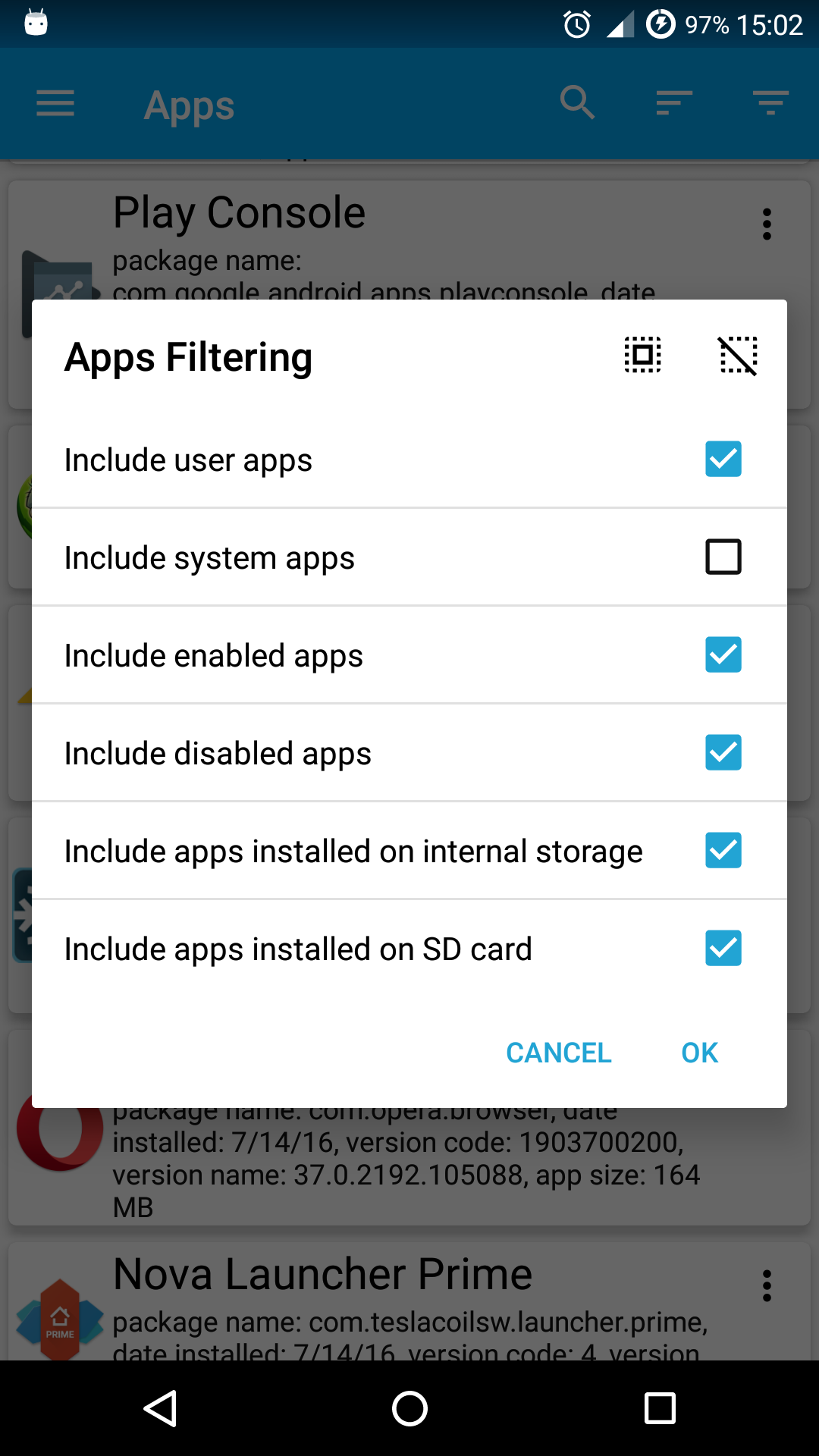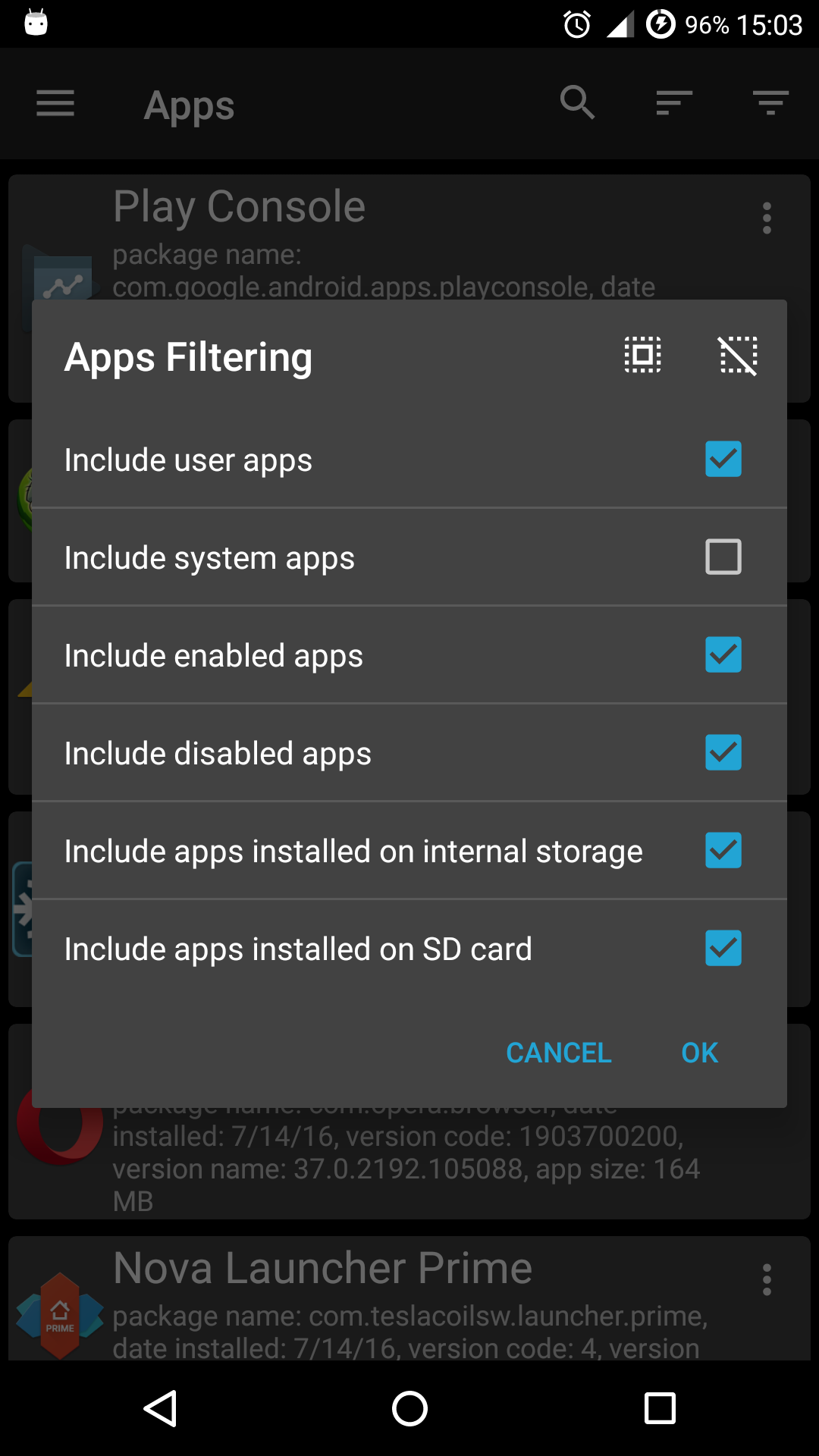Had some trouble implementing the suggested solutions from StrikeForceZero and Luke Sleeman, so I wanted to contribute my experience. I'm sure there's just something I'm missing so feedback would be much appreciated.
What I did was the following:
Create a style using the provided PopupTheme, straight copy/paste:
<style name="PopupTheme" parent="android:Theme.Holo.Light.Dialog">
<item name="android:windowIsFloating">false</item>
<item name="android:windowContentOverlay">@null</item>
<item name="android:windowSoftInputMode">stateAlwaysHidden</item>
<item name="android:windowActionModeOverlay">true</item>
<item name="android:windowIsTranslucent">true</item>
</style>
Add the showAsPopup() method as a method in the fragment which would open the fake dialog fragment, straight copy/paste:
private void showAsPopup(Activity activity) {
//To show activity as dialog and dim the background, you need to declare android:theme="@style/PopupTheme" on for the chosen activity on the manifest
activity.requestWindowFeature(Window.FEATURE_ACTION_BAR);
activity.getWindow().setFlags(WindowManager.LayoutParams.FLAG_DIM_BEHIND,
WindowManager.LayoutParams.FLAG_DIM_BEHIND);
LayoutParams params = activity.getWindow().getAttributes();
params.alpha = 1.0f;
params.dimAmount = 0f;
activity.getWindow().setAttributes((android.view.WindowManager.LayoutParams) params);
// This sets the window size, while working around the IllegalStateException thrown by ActionBarView
activity.getWindow().setLayout(850,850);
}
Create an instance of the new activity using a simple new() call, and then pass it to the showAsPopup() method:
DialogTestActivity test = new DialogTestActivity();
showAsPopup(test);
For the purpose of the test (I was just trying to confirm that I could open an activity that is presented as a dialog with an action bar) I used an extremely simple test, stolen directly from the button view api demo (for the layout file, see buttons_1.xml in the api demos):
public class DialogTestActivity extends Activity {
@Override
protected void onCreate(Bundle savedInstanceState) {
super.onCreate(savedInstanceState);
setContentView(R.layout.buttons_test);
}
}
Unfortunately, every time I tried this, I get an unspecified null pointer exception on the very first call, activity.requestWindowFeature(Window.FEATURE_ACTION_BAR);
04-29 16:39:05.361: W/System.err(15134): java.lang.NullPointerException
04-29 16:39:05.361: W/System.err(15134): at android.app.Activity.requestWindowFeature(Activity.java:3244)
04-29 16:39:05.371: W/System.err(15134): at packagenameremovedforlegalreasons.classname.showAsPopup(classname.java:602)
04-29 16:39:05.371: W/System.err(15134): at packagenameremovedforlegalreasons.classname.onMapLongClick(classname.java:595)
04-29 16:39:05.371: W/System.err(15134): at com.google.android.gms.maps.GoogleMap$5.onMapLongClick(Unknown Source)
04-29 16:39:05.371: W/System.err(15134): at com.google.android.gms.internal.k$a.onTransact(Unknown Source)
04-29 16:39:05.381: W/System.err(15134): at android.os.Binder.transact(Binder.java:310)
04-29 16:39:05.381: W/System.err(15134): at com.google.android.gms.maps.internal.IOnMapLongClickListener$Stub$Proxy.onMapLongClick(IOnMapLongClickListener.java:93)
04-29 16:39:05.381: W/System.err(15134): at maps.i.s.a(Unknown Source)
04-29 16:39:05.381: W/System.err(15134): at maps.y.v.d(Unknown Source)
04-29 16:39:05.381: W/System.err(15134): at maps.y.bf.onLongPress(Unknown Source)
04-29 16:39:05.381: W/System.err(15134): at maps.d.v.onLongPress(Unknown Source)
04-29 16:39:05.381: W/System.err(15134): at maps.d.h.c(Unknown Source)
04-29 16:39:05.381: W/System.err(15134): at maps.d.h.c(Unknown Source)
04-29 16:39:05.381: W/System.err(15134): at maps.d.j.handleMessage(Unknown Source)
04-29 16:39:05.391: W/System.err(15134): at android.os.Handler.dispatchMessage(Handler.java:99)
04-29 16:39:05.391: W/System.err(15134): at android.os.Looper.loop(Looper.java:137)
04-29 16:39:05.391: W/System.err(15134): at android.app.ActivityThread.main(ActivityThread.java:5041)
04-29 16:39:05.391: W/System.err(15134): at java.lang.reflect.Method.invokeNative(Native Method)
04-29 16:39:05.391: W/System.err(15134): at java.lang.reflect.Method.invoke(Method.java:511)
04-29 16:39:05.391: W/System.err(15134): at com.android.internal.os.ZygoteInit$MethodAndArgsCaller.run(ZygoteInit.java:793)
04-29 16:39:05.391: W/System.err(15134): at com.android.internal.os.ZygoteInit.main(ZygoteInit.java:560)
04-29 16:39:05.391: W/System.err(15134): at dalvik.system.NativeStart.main(Native Method)
As you can see from the stack trace, the intended behavior is to open the window on a long press on a GoogleMap instance (using the MapFragments from API 2). So my first thought was that there was an issue from trying to open from a Fragment, so I passed the call back to the owning Activity. Same error, same no additional information.
My best guess at this point was that a new() call didn't sufficiently instantiate the class/view in order to make calls to modify its view. Turns out that this appears to be at least somewhat true, as migrating the view modification code into the activity and simply opening the activity in the normal way works:
Calling activity:
public void openMapDialog()
{
Intent intent = new Intent(this, DialogTestActivity.class);
startActivity(intent);
}
New class code:
public class DialogTestActivity extends Activity {
@Override
protected void onCreate(Bundle savedInstanceState) {
super.onCreate(savedInstanceState);
// From: https://mcmap.net/q/363480/-actionbar-in-a-dialogfragment
this.requestWindowFeature(Window.FEATURE_ACTION_BAR);
this.getWindow().setFlags(WindowManager.LayoutParams.FLAG_DIM_BEHIND, WindowManager.LayoutParams.FLAG_DIM_BEHIND);
LayoutParams params = this.getWindow().getAttributes();
params.alpha = 1.0f;
params.dimAmount = 0f;
this.getWindow().setAttributes((android.view.WindowManager.LayoutParams) params);
// This sets the window size, while working around the IllegalStateException thrown by ActionBarView
this.getWindow().setLayout(600,600);
setContentView(R.layout.buttons_test);
}
}
So I guess the point of me posting all of this is to clarify that if you want to do what the above posters suggest, you can't just new() an activity and call showAsPopup(). This may be my inexperience with Android showing through, but while this seems a bit obvious, it also seems natural to interpret showAsPopup() as being called by the current view, not the view being created, as you're passing in the activity instance (which would just be this if it was supposed to be done in onCreate() like I ended up doing).
So if the intention is to call showAsPopup() in the creating activity and not the created activity, it's not obvious how to get the Activity instance that is modifiable prior to onCreate() being called. The problem being that you can't call things like requestWindowFeature() after setContentView() is called (example), which is a problem since it is typically called in onCreate().
Again, if there is an easy/better way to do this, I would very much appreciate feedback. Hopefully this is helpful for people who want to use this approach.




